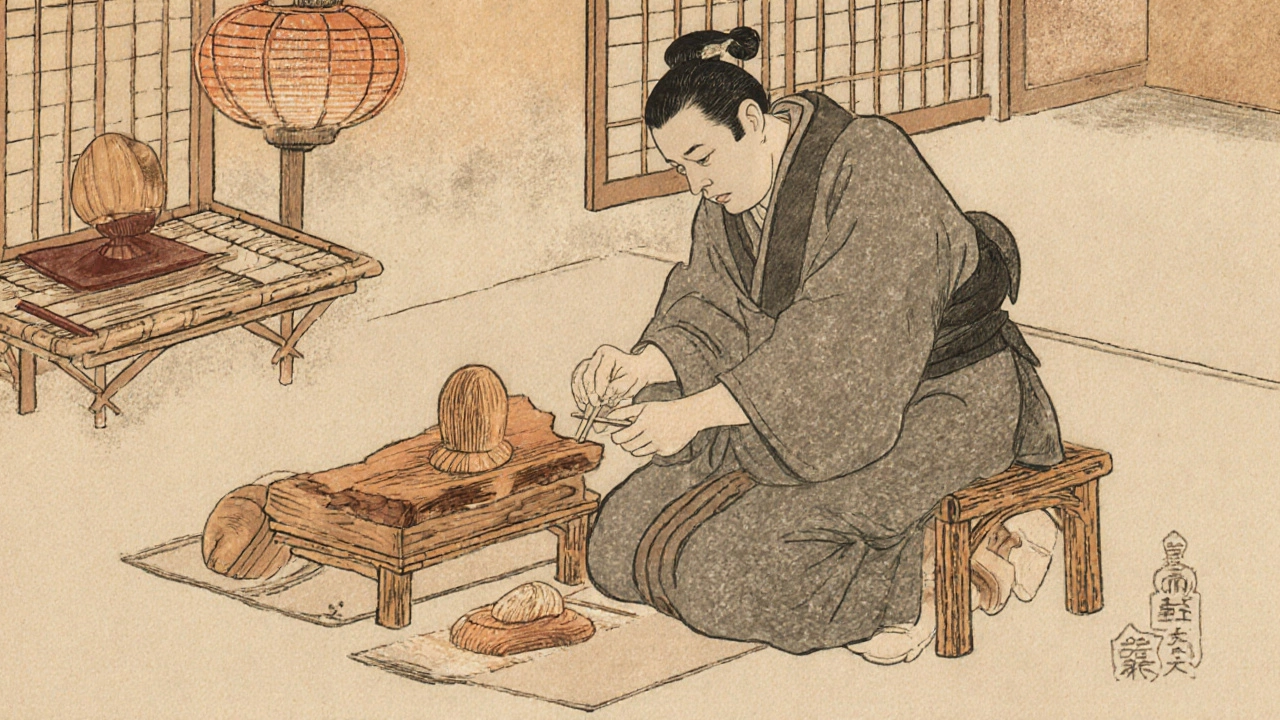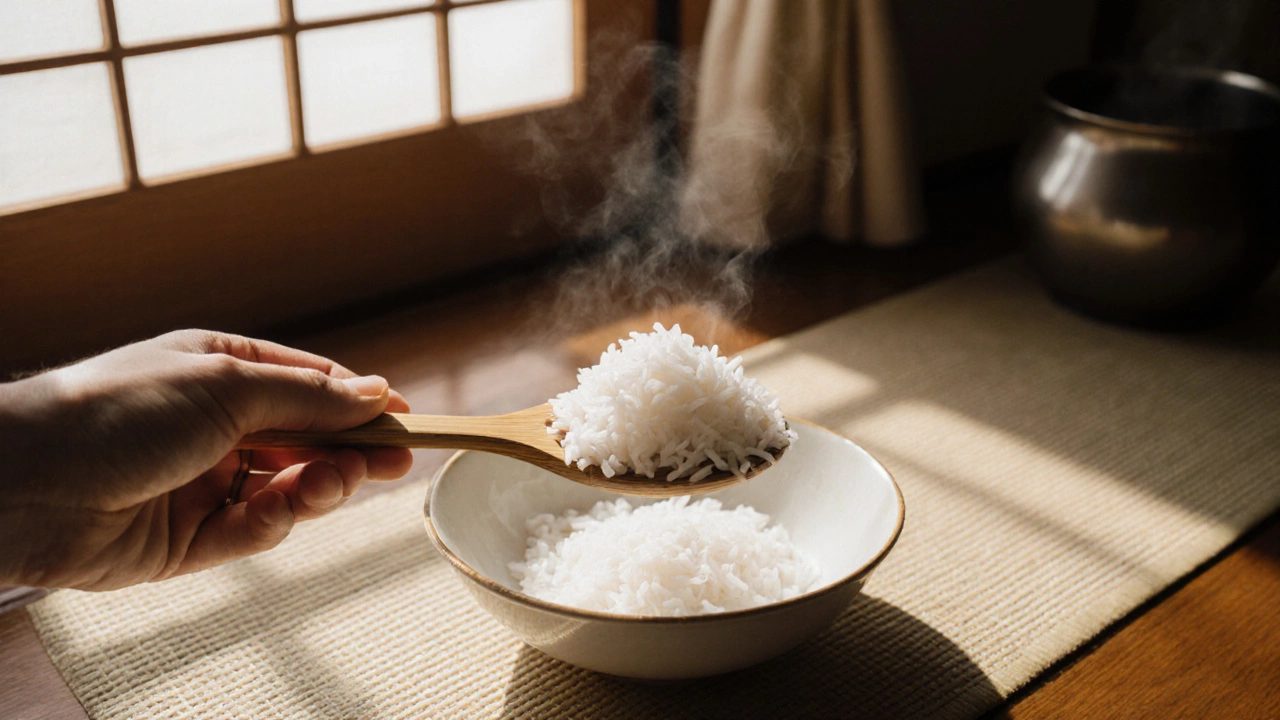Shamoji Material Selector
Choose your preferred shamoji material to learn about its features, benefits, and best uses.
Bamboo
Lightweight and natural antimicrobial
Wood (Cedar, Cypress)
Sturdy with pleasant scent
Plastic
Dishwasher safe and affordable
Silicone
Heat-resistant and non-stick
Your Selected Material:
When you picture a Japanese kitchen, a flat wooden paddle gliding through fluffy rice is one of the first images that comes to mind. That unassuming tool is called a Japanese ladle, known locally as a shamoji - a wooden or bamboo paddle used for serving rice, soup, and other dishes in Japan. Below we’ll unpack what a shamoji really is, why it matters, and how you can pick the perfect one for your own kitchen.
What Exactly Is a Shamoji?
A shamoji is a ladle‑style utensil, typically 12-15cm long, with a shallow, wide bowl and a long handle. While the shape resembles a Western soup ladle, Japanese chefs use it for a broader range of tasks: scooping rice, stirring sushi vinegar, lifting tempura from hot oil, and even serving broth. Its flat, low‑profile bowl lets you slide under a mound of rice without smashing the grains, which is why it’s the go‑to tool for both home cooks and restaurant chefs.
History and Cultural Role
The shamoji dates back to the Edo period (1603‑1868) when rice was the cornerstone of Japanese diet and economy. Early shamoji were carved from single pieces of Japanese cedar (sugi) or cypress (hinoki), prized for their durability and subtle fragrance. Over time, the utensil became a symbol of hospitality - offering a guest a perfectly portioned serving of rice with a clean, elegant shamoji is considered a sign of respect.
In many traditional kitchens, the shamoji is stored in a bamboo holder called a shamoji kake to keep it dry and prevent the wood from warping. Seasonal festivals often feature beautifully lacquered shamoji, turning a simple kitchen tool into a decorative heirloom.

Materials and Types
Modern shamoji come in a range of materials, each with its own pros and cons. Below is a quick comparison to help you decide which fits your cooking style.
| Material | Pros | Cons | Typical Cost (USD) |
|---|---|---|---|
| Bamboo | Lightweight, natural antimicrobial properties, classic look | Can crack if left soaking; needs oiling | 5‑12 |
| Wood (Cedar, Cypress) | Sturdy, pleasant scent, lasts decades with care | Heavier, requires periodic seasoning | 8‑20 |
| Plastic (Polypropylene) | Dishwasher safe, inexpensive, color variety | Can retain odors; less authentic feel | 3‑8 |
| Silicone | Heat‑resistant up to 250°C, non‑stick surface, flexible | Less rigid for scooping rice; premium price | 10‑18 |
If you love the traditional aesthetic and plan to use the shamoji daily, bamboo or cedar is the way to go. For busy families who want a low‑maintenance option, food‑grade plastic works well.
How to Use a Shamoji Correctly
- Serving rice: Gently scoop a small amount of rice, tilt the shamoji, and use a quick flick of the wrist to release a neat mound onto the plate. Avoid digging too deep; the shallow bowl is designed for a light touch.
- Mixing sushi rice: Place the hot rice in a wooden tub (hangiri), drizzle the seasoned vinegar, and use the shamoji to fold the rice. The flat surface spreads the seasoning evenly without crushing the grains.
- Transferring broth: When ladling miso soup or clear broth, tip the shamoji slowly to keep the surface film smooth. The wooden handle prevents heat transfer, protecting your hand.
- Frying tempura: A bamboo shamoji can lift delicate pieces from hot oil without splashing, thanks to its wide, shallow bowl.
The key is to treat the shamoji as an extension of your hand-light, precise, and respectful of the food’s texture.
Care and Maintenance Tips
Proper upkeep prolongs the life of a wooden or bamboo shamoji. Follow these steps:
- Hand‑wash only: Use warm water and a mild dish soap. Avoid soaking for more than 5minutes.
- Dry promptly: Pat dry with a clean cloth, then stand the shamoji upright to air‑dry.
- Season occasionally: Lightly rub the surface with a food‑grade mineral oil or a thin layer of sesame oil once a month. This prevents cracking and restores the natural sheen.
- Avoid the dishwasher: The high heat and harsh detergents can cause warping and strip the protective oil.
- Store in a shamoji holder: A bamboo tube or a ventilated rack keeps the utensil dry and mold‑free.
Plastic or silicone shamoji are dishwasher safe, but it’s still a good idea to place them on the top rack to avoid warping from extreme heat.
Buying Guide: Choosing the Right Shamoji
When you’re ready to add a shamoji to your kitchen, consider these factors:
- Purpose: If you mainly serve rice, a traditional bamboo paddle is ideal. For hot broth or oil work, a heat‑resistant silicone model offers extra safety.
- Length of handle: A longer handle provides more leverage for stirring large pots, while a shorter one offers better control for plating.
- Finish: Look for a smooth, sanded surface. Rough finishes can snag rice grains and trap food particles.
- Craftsmanship: Hand‑carved shamoji often feature subtle grain patterns and may carry a maker’s stamp, indicating authenticity.
- Price vs. durability: While a $5 plastic shamoji works fine, a $15-$20 bamboo one can last many years with proper care, delivering better value over time.
Many online Japanese specialty shops offer sets that include a shamoji, a bamboo holder, and a matching spoon (shakushi). Buying a set ensures color and material consistency across your utensils.
Alternatives and Similar Tools
If you can’t find a shamoji, a few other kitchen tools can fill the gap:
- Rice paddle (Kojirō): Similar in shape but often made of plastic; good for quick service.
- Western soup ladle: Too deep for rice but works for broth.
- Silicone spatula: Flexible enough to scrape rice from bowls, though it lacks the classic wooden feel.
Each alternative has trade‑offs in texture, heat resistance, and authenticity, so choose based on what matters most to you.
Frequently Asked Questions
What is the Japanese word for a ladle?
The general term for a ladle in Japanese is shamoji. It specifically refers to the flat, wooden paddle used for rice and soup.
Can I use a shamoji for non‑Japanese dishes?
Absolutely. Its shallow bowl makes it great for serving risotto, oatmeal, or even stirring sauces where you need a gentle touch.
How do I prevent my bamboo shamoji from cracking?
Avoid soaking it, dry it quickly, and season it with a light coating of food‑grade oil once a month. Storing it upright in a dry holder also helps.
Is a silicone shamoji safe for high‑heat cooking?
Yes. Food‑grade silicone tolerates temperatures up to about 250°C (482°F), making it suitable for deep‑frying tempura or stirring hot broth.
Do I need a special holder for my shamoji?
A bamboo holder (shamoji kake) isn’t required, but it keeps the paddle dry and protects the handle from kitchen grime. It’s a common feature in traditional Japanese kitchens.
Can a plastic shamoji be used in a professional sushi restaurant?
Many high‑end sushi venues prefer handcrafted bamboo or wood for authenticity, but a high‑quality, BPA‑free plastic shamoji can be acceptable for high‑volume service where durability matters.
Whether you’re a home cook trying to perfect a bowl of sushi rice or a chef needing a reliable tool for hot broth, the shamoji delivers a blend of tradition and practicality. Choose the material that matches your habits, care for it properly, and you’ll enjoy a piece of Japanese culinary heritage for years to come.

